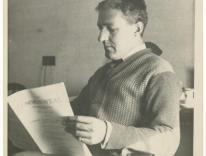My characteristically spotty effort at wit in a headline below on needle exchanges is a good excuse to point to a biblical translation issue that may be well known to many here but which was new to me, and one of those quirks I always find intriguing. Brad Miner at The Catholic Thing was writing about Zeffirelli's "Jesus of Nazareth" and the screenwriter, Anthony Burgess, whose knowledge of scripture was pretty impressive:
Anyway, it was in reading Burgess on the subject of his adventures with Zeffirelli that I first became aware of the camel-rope controversy of Matthew 19:23-25. Thats the story of the young man who asks to follow the Jesus. Our Lord bluntly responds that he should liquidate his assets and invest it all in charity. The young man is rich and skulks away. Jesus turns to his disciples: Again I tell you, it is easier for a camel to go through the eye of a needle than for someone who is rich to enter the kingdom of God.Now in Greek, the primary language of the Gospel, the word for camel is (depending on how its transliterated) kamilon. But Burgess argued (and he is one of many who have) that since the word for rope, kamiilon, is essentially a homophone, the passage actually makes more sense if Jesus is telling his fisherman followers, in whose former trade cords and nets played such a prominent role, to imagine trying to thread a thick, nautical rope through a needles eye.Others argue that the camel, the largest thing around, made for vivid imagery: big beast, tiny opening. Still others say there was once an actual gate in Jerusalems wall called Needles Eye. Other ancient cities had such narrow, low-lintel passageways designed to be the only ones left open late and requiring travelers to dismount, unburden their camels, and squeeze through. A security measure. But no archaeological evidence exists to indicate that Jerusalem ever had a Needles Eye. More than that, theres support for the rope hypothesis in Aramaic, the language Jesus spoke most of the time, in which the words for camel and rope are the same: gml. (As in Hebrew, there are no written vowels in Aramaic.)
As Miner asks, does it matter which word or image was used? Probably not. But for me the interest in such things plays up again the perennial fascination in the historical Jesus, and trying to "be there" with his listeners.


